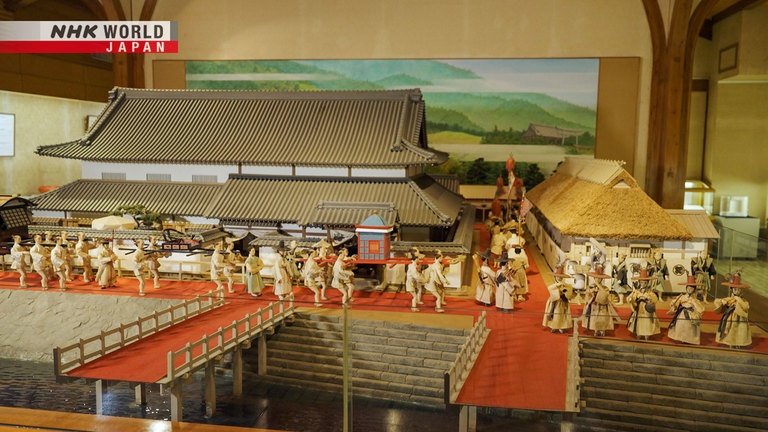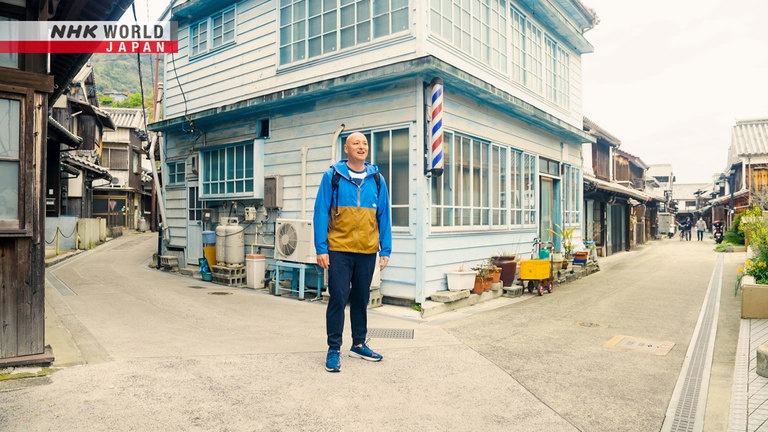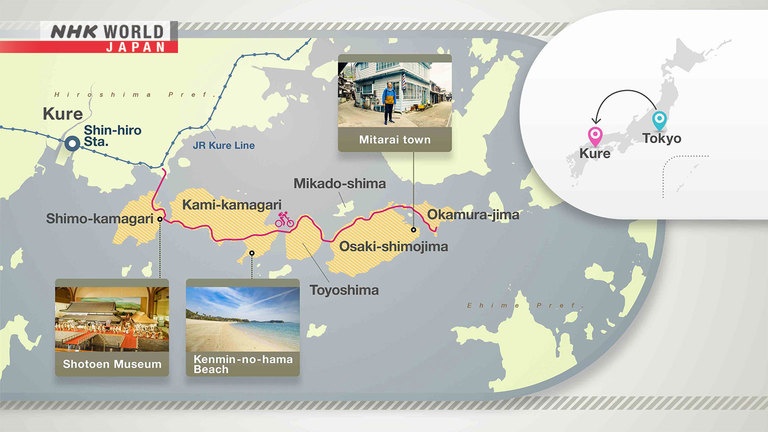Tobishima Kaido: Taking It Slow on Golden Isles
The Tobishima Kaido is a network of bridges linking seven Seto Inland Sea islands. The route starts in Shimo-kamagari near Kure in Hiroshima Prefecture and extends to Okamura in Ehime Prefecture. Osakishimo-jima's Mitarai district prospered as a port of call for Kitamaebune merchant ships, and retains the townscape from the Edo period. The island is also famous for its citrus farming, which dates back over 100 years. Britain Tom Miyagawa Coulton, who lives in Osakishimo-jima, takes us around the islands steeped in history.
Shotoen Museum

Features the area's rich maritime history, including materials related to Korean delegations to Japan.
Mitarai Town

Designated as an Important Preservation District for Groups of Traditional Buildings in 1994 for its Edo period residences.
Kenmin-no-hama

A gorgeous sandy extending 400 meters. A small museum nearby features the area's seaweed-salt tradition.
Access

To reach Osakishimo-jima, take a limousine bus from Hiroshima Airport to Shinhiro Station. From there, board a local bus for Mitarai Port.
Transcript
"Journeys in Japan"
Oh, this is lovely. Wow.
So, I'm cycling on the Tobishima Kaido.
This is a really popular cycling route.
Yeah, perfect.
The Tobishima Kaido is a bridge network
linking seven Seto Inland Sea islands.
Hi, I'm Tom Miyagawa Coulton, a photographer and a writer.
In 2015, I moved here to the Tobishima Kaido islands
to Osaki-shimojima Island.
Today I'd like to introduce you to the people and the places
that make this region so special.
For years, Tom Miyagawa Coulton
has been documenting in words and images
the local food culture and lifestyle.
And now he celebrates these enchanting citrus-scented islands
with us on "Journeys in Japan."
Tobishima Kaido
Taking it Slow on Golden Isles
The Tobishima Kaido is located about 650 kilometers west of Tokyo.
The route starts from Shimo-kamagari,
which is southeast of Kure in Hiroshima,
and ends on Okamura in Ehime.
I'm on Shimo-kamagari Island, the first island on the Tobishima Kaido.
In the past, this used to be a very busy port for the ships
passing through the Seto Inland Sea.
Today it's so peaceful, it's hard to imagine it as a busy port.
This museum has lots of exhibits detailing the history of this island.
Let's take a look.
Amazing.
- They're all ships, right?
- Yes.
This scroll depicts a Korean delegation navigating the Seto Inland Sea in 1748.
Over 400 ships came to this port.
Why did they land at Shimo-kamagari?
When the Korean court sent a diplomatic mission to Japan,
the Shogunate designated multiple places for welcoming them.
The Hiroshima domain was ordered to host them in Shimo-kamagari and Tomonoura.
So, the delegation called here.
What a view. Wow.
I think you can easily see the tidal currents.
The Seto Inland Sea tide ebbs and flows every 6 hours.
In the olden days, ships didn't have engines. They navigated by riding on the tide.
Not only the Korean mission, but when others called,
Shimo-kamagari played a key role as a stop-over port.
That's amazing.
Before moving to this island,
I was living in Tokyo, one of the biggest cities in the world.
You can see why I decided to swap the hustle and bustle of the big city
for this island life close to nature in the Seto Inland Sea.
Hi. So, I've crossed from Shimo-kamagari Island for six islands.
And then, this is Okamura Island, the final island on the Tobishima Kaido.
The town you can see across the water there
is Mitarai on Osaki-shimojima Island,
which has been my home for the last eight years.
(Mitarai, Osaki-shimojima)
Mitarai flourished from the 18th century to the 20th
as a port of call for the Kitamae-bune merchant ships
sailing between Osaka and points heading north along the Sea of Japan.
As you walk around the town,
it's really clear how this town prospered in the past.
There are so many beautiful buildings in Mitarai
that have been preserved since the 18th century.
Seeing as we're here, let me show you around this town I call home.
Now, which way shall we go? Let's go this way.
So, a big reason why so many of these buildings still stand in Mitarai
is because the whole town has been designated
as a historical preservation district.
So, in Mitarai, you got all these little tiny alleyways.
And it's almost like a maze, which makes it really fun to discover.
Like, for instance, here you've got an alleyway leading into another alleyway.
Let's try going this way.
So, another street with lots of historical buildings.
It's fabulous. It's very picturesque.
We've actually arrived in front of my home.
So, this house is actually over 100 years old.
But I think it still looks pretty good.
As you can see, there are not many people walking the streets of Mitarai.
And that's because Mitarai, like a lot of places in rural Japan,
is suffering from an aging and declining population.
About 70 percent of the people who live here are over 65 years old,
and there are only about 200 people in Mitarai.
Because of this, many of these houses, these historical houses are in fact empty.
But as you can see here,
a lot of these houses have these exquisite flower displays in front of them.
So, there are, in fact, a group of ladies in Mitarai
who are responsible for taking care of these flowers.
- Katayama-san, hello.
- Hello.
As always, you are creating a beautiful floral arrangement.
Irises bloomed for the first time this season, so it's the starring flower.
It's cherry blossom season, so I added some.
There?
My image is of a small cherry tree.
You have more places to decorate, right?
That's right.
How long have you been doing this?
I am in my 21st year.
Isn't it hard to always go and buy flowers?
I don't buy the flowers. We grow them ourselves.
- All of them?
- Yes.
We arrange the flowers that we plant ourselves.
There are still many vacant homes now.
But in the past, some were on the verge of collapse.
The area had a deserted feeling.
To lift the atmosphere, we arranged flowers on blinds like this.
It looked bright and attractive.
And it changed our town's ambiance. People say they are calming.
So not only are these empty houses being decorated
by these gorgeous flower displays,
but they're also being renovated and given a new lease on life.
One person who's doing this more than most other people
is my friend Inoue-san who we're about to meet.
And here he is.
- Sorry to keep you waiting.
- Hello.
For Hiroshima native Inoue Akira,
it all started when he converted a vacant home into a cafe in 2011.
Since then, he has revived many abandoned residences into restaurants,
lodgings and galleries.
Did you know you wanted to start a cafe here?
Not exactly. At the time, there were no places to hang out.
I realized a cafe was needed and made it happen. That was the start.
I use what is available to meet the needs of the community.
So, this is Inoue-san's guesthouse called the KUSUSHI.
It's such a charming building.
It's about 110 years old, and was originally a clinic.
It was vacant for just over 10 years. I thought that was a shame.
The owner allowed me to use the space if it would help the town.
And I turned it into lodgings.
Come in.
Amazing. The beams were exposed...
Originally there was a ceiling here.
I thought it would be interesting to show the woodwork.
The facade is western-style, but inside it is Japanese.
I think these are also design elements.
This was the only tatami room. People would get IV drips here.
I displayed items that the clinic received from pharmaceutical companies.
This examination table was also used here.
This was the examination room. We are now renovating into a bar.
The doctor used that desk, microscope and other things.
This is the waiting room. And the sofa used at the time.
It's comfortable.
Though it's a bit soft.
I want to preserve the identity of this former clinic.
I hope my renovation and management styles
will be good so I can pass on the baton.
I hope you liked looking around Mitarai.
As you can see, the local residents here are working hard
to preserve this town for future generations.
Tomorrow, I'll be showing you a different side to the island.
Good morning. So today we're going to learn
about a different aspect to this island.
As you can see here,
this island has perfect conditions for growing delicious citrus fruit.
Osaki-shimojima Island is renowned for its delicious citrus fruits
which have been cultivated here for over 100 years.
The island's citrus market was once huge,
with canned fruit even being exported to the United States.
I'm here to meet Sueoka-san, a sixth-generation citrus farmer,
to help him harvest some oranges. Let's go.
- Hello.
- Hello, Tom.
- We'll work here today?
- Yes.
- Will you join?
- Sure.
- I have brought a basket for you.
- Thanks.
First snip long, then cut short.
- What kind of citrus is this?
- It's called Kiyomi.
They taste best right now.
They're known for being juicy. They taste great in summer, freshly squeezed.
So, one of the benefits of living on a citrus island like this is that
you get to help these citrus farmers harvest the oranges,
and then, you got to work hard, but in return you often
end up with a present of delicious citrus.
How many kinds of citrus do you grow?
I am growing three varieties, mikan, lemon and Kiyomi.
In the past, my crops were 70 to 80 percent mikan.
We used to have terraced mikan fields all the way to the top.
Now, we lack successors due to our aging society.
Many farms are closing. Abandoned fields are increasing.
In the olden days, Ocho-mikan were presented to the emperor.
Premium mikan were cultivated here.
- Over there?
- Yes, in those fields.
- Right over there?
- Yes.
With the citrus trade liberalization in the 1980s,
the price of domestic mikan plummeted.
And farmers' profits shrank. This may be why we can't find people to take over.
Here is my lemon field.
Lemons account for about 60 percent of my production.
For about 15 years,
consumers have recognized domestic lemons for quality and flavor.
Also, for their safety. Japan's lemons are booming now.
Domestic lemons account for only about 10 percent of the market.
But I believe demand will increase.
I am working hard to make lemons our island's leading product.
Demand for this local specialty called Ocho-lemon is now rising nationwide.
And not just for the whole fruit, but also for an array of related products.
So, since I moved to the island, Atsuka-san has been like a grandmother to me.
And today she's making her famous island marmalade.
It smells amazing.
It's come out quite good.
We use the juice of Dekopon citrus and lemon. At the very end, I add whiskey.
About 6 years ago, I added whiskey for the first time.
I asked people to sample it and received good ratings.
So, I started adding whiskey.
It's ready.
Atsuka's marmalade took the bronze at a 2017 contest in England.
And now it's the island's leading local specialty.
Please try it.
Wow, this looks amazing.
Yeah. So, the whiskey adds that kind of extra deep flavor
to the marmalade. It's amazing.
I turned 87.
Recently, this work has become hard for me.
Since last year, my grandson started helping me.
I live in Hiroshima. During the week, I work in the city.
On Friday night, I come here and return home on Sunday.
I thought this would be easy work, but I soon discovered it was quite tiring.
I now know how hard my grandma has worked all these years.
I want to continue making great marmalade by sticking to her method,
so her work is not in vain.
As long as I am in good health,
I can make marmalade with my grandson. I am very happy.
So finally, I want to cross over to that island over there.
That's Mikado Island.
It's a really tiny island with a population of around a dozen people.
But there's someone over there who's growing lemons I want to meet.
- Takeda-san, nice to meet you. I'm Tom.
- Nice to meet you.
Takeda Mari tends the orchards at a sake brewery
which started lemon cultivation in 2016.
These are magnificent lemons.
We don't use agricultural chemicals, so the aroma is excellent.
- Please smell it.
- May I?
You can even eat the peel as it's organic. We have branded this as Mikado Lemon.
Yeah, there's a real kind of deep lemon fragrance that's coming from this lemon.
- It makes me want to take a bite.
- Oh, please do.
At this time of the year, it's delicious.
Then, I'll take a bite.
It's the first time I've done that in my life.
But it's amazing. It's not sour. It's not
acidic. If anything, it's quite sweet.
That's interesting. Yeah.
Since we don't use chemicals, the flavor is less astringent. Everyone says so.
Mikado-shima's sun and sea breezes,
as well as the microorganisms in the soil nurture the lemons.
We squeezed Mikado Lemons and made sparkling Japanese sake.
Cheers.
That's delicious.
I mean, you can really taste the deep flavors of the lemons.
The sweet flavor comes from the "koji" malted rice. No sugar is added.
It's rare getting such a fresh lemon taste.
Thank you for saying so.
We believe this will appeal to people worldwide.
We are working hard hoping our lemon will take flight around the world.
This land has given all this to us.
We will pass this on to the next generation.
So, we will keep on producing lemons and sake.
- That's wonderful. I wish you success.
- Thank you very much.
Takeda's passion has inspired others.
Takeuchi Shintaro launched his farm in Osaki-shimojima five years ago.
These are the lemon trees I planted in the first year
I started farming without using agricultural chemicals.
Growing fruit without agricultural chemicals must be hard.
It is hard.
I hope to become a model case on this island
for agricultural chemical-free cultivation.
I still have limited experience,
but I intend to establish agricultural chemical-free cultivation.
I hope you enjoyed this journey around the Tobishima Kaido
and meeting the amazing people who live and work on these islands.
Since I moved here, I've been continually amazed by the kindness of the locals.
They welcome newcomers,
and they willingly share their knowledge and offer their help.
Although Mitarai and the Tobishima Kaido
face the same challenges as many places in Japan,
you can see how the people here are working hard
to try to preserve this way of life for future generations.
Thank you again for joining me on this journey,
and I hope to see you on these islands very soon.
To reach Osaki-shimojima,
take a Limousine Bus from Hiroshima Airport
to Shin-hiro Station.
From there, transfer to a local bus for Mitarai.
The entire journey takes two and a half hours.
Don't miss Kami-kamagari Island's long, sandy white beach.
Salt-making ruins were excavated on this beach.
Visitors can take in replicas and displays showing this history
that dates back to the fifth century.
The salt that they created here
combines seaweed with seawater.
There is no rock salt in Japan, so people have long used seawater.
The local style called "moshio" is seawater and seaweed
simmered down together until a complex salt crystallizes.
25 years ago, local volunteers revived moshio.
Produced at a factory by the beach,
visitors can observe the process with prior reservation.
The seaweed salt embodies the bounty of the Setouchi area.